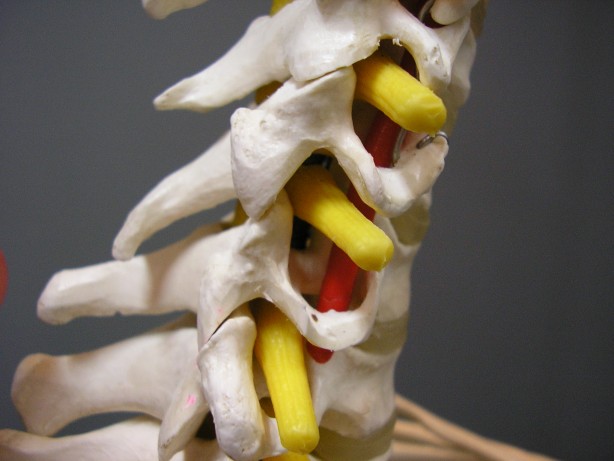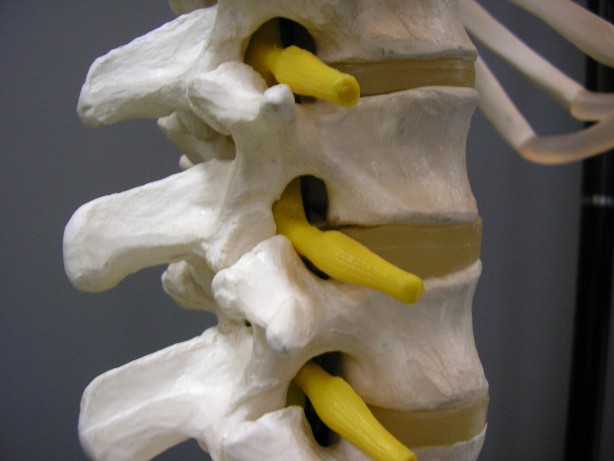Nerve Root Irritation
What is it? | What causes it? | Symptoms | Solutions | What can I do? | Main aim
What is it?
Nerve root irritation is a condition whereby a nerve becomes irritated by adjacent muscle/joint-structures/swelling/blood etc, most often this is at the point where it exits your spine at your neck or your lower back (the ‘nerve root’).
What causes it?
Most commonly this occurs when a structure adjacent to the nerve becomes swollen, inflamed and/or spasmed as a result of protective guarding, and accumulative strain to the structure. e.g. a joint, ligament and/or muscle.
What are the symptoms?
It is commonly known that nerve irritation can cause symptoms such as radiating pain down the arm or the leg, numbness/pins and needles.
The nerve root are some of the most sensitive structures in the body. When a nerve is irritated it sends strong signals to the brain to let it know it’s suffering. The brain then interprets these signals and creates protective responses to avoid further irritation/damage to the nerve:
- Radiating pain down the arm or leg
- Muscle tightness and guarding
- Numbness/ pins and needles
- Tingling, cramping
But if I don’t get any of these symptoms, how does this relate to my problem?
Everybody’s protective responses to nerve root irritation (symptoms and signs/problems) are individual and not necessarily the same as someone else experiences. Responses may vary from person to person and may include:
- Aches | Sometimes pain medication has little/no effect on nerve root irritation
- Difficulty finding a position to ease the pain
- Latent pain/tightness to stretching, maintained postures, and any activity
- No pain or symptoms, but tightness that doesn't loosen up | For examples, neck, back, and/or hamstring muscles
Solution | How is it fixed?
For most rapid results most nerve root irritation condition require specific manual therapy treatment1.
Rest is not normally helpful. Symptoms may subside with long periods of rest, and commonly the symptoms recur with return to activity. We find one of the most common causes for recurring pain and injury is due to nerve root irritation not being fixed.
For strong nerve root irritation some medications prescribed by your doctor may have good effect. These are normally specific low doses of anti-epileptic, or anti-depressant medications. This doesn't mean the cause is from epilepsy or depression, it just happens to be these medications are good at affecting nerve irritation.
Below is a short summary video of a low back and leg nerve root irritation being treated. In this case the nerve root irritation tests were fixed with two 30-minute treatments in one day. This is very rapid results and typical response to the types of treatment techniques used by Ridgway Method Certified Practitioners.
Important note: don't try this at home. Nerve root treatments are very specific and require advanced training. It is highly likely to make a condition worse if these techniques are tried by a person who doesn't have specific advanced training.
What can I do?
1. While the nerve irritation is present the best you can do is to prevent aggravating activities that further irritate. More details about prevention of aggravation are described in the sections below.
2. After the nerve root irritation has been fixed you can prevent recurrence by looking after the primary contributing factor (PCF). This is the reason for why the nerves got aggravated in the first place. In most cases this requires a change in bad habits, improvements in posture and muscle control. Ridgway Method Certified Practitioners are trained to help you with this.
Will it improve my pain/function straight away?
For most people pain and function improves immediately after a nerve root irritation is fixed. In some cases the pain in function improves only once the primary contributing factor (PCF) to the nerve root irritation is solved - the next step in the Ridgway Method problem solving approach.
Either way if the nerve root irritation is not fixed any treatments will probably not work well. The reason being, nerves are the most sensitive structure in the body and the brain protects and guards irritation to the structures over and above all other structures.
Should my pain go away after my nerves are fixed?
As explained above, sometimes nerve root irritation directly causes pain. Other times not. Either way is the most important thing to treat first to reach your goals.
Why is it important: to treat if there are no symptoms?
Sensitive manual therapy tests that measure nerve root irritation are indicators of the body's protective guarding, even if there are no nerve related symptoms. If this protective guarding is not fixed first:
- The treatment effectiveness is lessened
- Slow progress
- Treatment effect wont hold as well
- Less improvements or none at all
- Recurrence of the condition is likely
Therefore importance of addressing first. The overriding reason we find people have had persistent conditions, stubborn conditions, and recurrence of their conditions, is because the nerve root irritation had not been addressed.
If I have a nerve root irritation; what can I do about it?
Nerve root irritation is problematic to deal with because it usually doesn’t follow the normal rules of rest to help the condition resolve.
Rest without good treatment often delays recovery significantly.
Sometimes it even feels good to try to stretch the arm or leg affected or to do some light exercise. This temporarily ‘warms up’ the condition and for this reason it doesn’t feel so bad.
Unfortunately, by doing this you are actually aggravating the condition while it is warmed up and the pain comes back worse soon after you cool down, or in some cases, within a couple of hours or the next day.
The sooner you get good treatment the sooner you can be back to your activities.
While you are in the process of receiving good treatment and having the nerve irritation released, the best thing you can do in between sessions is avoid re-aggravation. This means spending as much time as possible either up and moving around or lying down.
If manual therapy treatment isn't helping quickly then we don't continue and we guide you to other investigations.
A good rule is to minimize sitting and minimize driving as this usually aggravates the joints and ligaments that are causing the nerve root irritation.
For most cases during the process of having your nerve root irritation treated, the following rules apply:
- NO stretching
- NO exercise
- DO NOT sit for longer than absolutely necessary
- DO NOT use the arm or leg in a stretched out position [no feet-up while sitting, no striding out with walking, no reaching behind to the back seat, no carrying in that arm or over that shoulder]
- DO NOT prop your head up with pillows to read/use a computer while lying on your back [lying on your side to read or having the laptop up high enough on cushions so you don’t have to prop up your head is OK]
- For the times you have to sit ensure you utilise the best possible ergonomic position, sit in a firm chair [like a dinning chair] and no sitting on couches
- For the times you have to drive ensure the seat is as close to the pedals as practical and your elbows are quite bent as you drive. Where possible get someone to drive for you, especially if you are having troubles using the stick or pedals [safety first]
- When you walk take small steps and do your best to avoid limping
Practitioners that would like to learn more are invited to see the Neural Dynamic Tests & Treatment Course details  »
»
The main aim
Our aim is to ensure you get back to a healthy life as soon as possible!
There aren’t many conditions where we ask you to avoid or severely limit exercise, but this is one of them.
All going to plan, you will only have to miss a few days of most of your regular life activities.
We will guide you, your family/significant others, your trainer and/or coach on how to best help you get back to your usual routine as quickly as possible.
We also look forward to showing you exercises and activities that you can do to speed up your recovery, after the nerve root irritation is fixed.
Please feel free to ask questions about nerve root irritation to a Ridgway Method Certified Practitioner, or email the Ridgway Institute International Team.
Do you know someone who might appreciate knowing this information? A family member, work colleague, friend, coach, instructor, local physiotherapist, doctor, etc. - then send them the link to this page | The research that this information is based on is so new the chances are that they wouldn't have heard about it.
1 Hall,T.M. & Elvey, R.L. (1999) Nerve trunk pain: physical diagnosis and treatment. Manual Therapy Masterclass, 4(2), 63-73... click here »
Further reading | The role of neural tension is hamstring flexibility... click here »


















